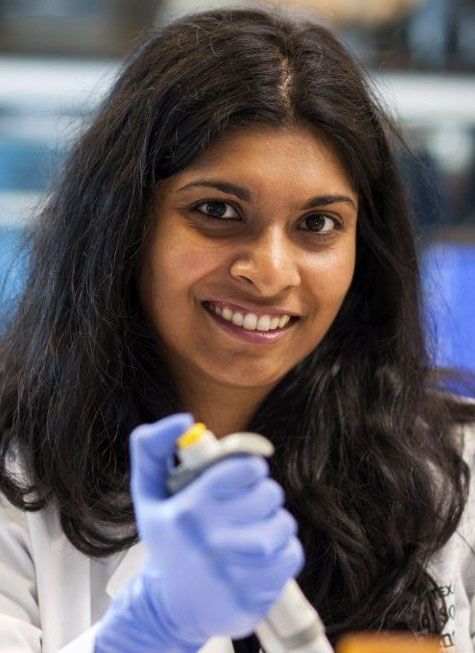Neoadjuvant Nivolumab/Ipilimumab Combo Effective but Toxic for Melanoma
Neoadjuvant nivolumab plus ipilimumab demonstrated almost a tripling in objective response rate compared with the PD-1 inhibitor alone but at the cost of significant added grade 3 adverse events for patients with high-risk resectable melanoma.
Sangeetha M. Reddy, MD, MSci, a fellow at the MD Anderson Cancer Center

Sangeetha M. Reddy, MD, MSci
Neoadjuvant treatment with the combination of nivolumab (Opdivo) and ipilimumab (Yervoy) demonstrated almost a tripling in objective response rate (ORR) compared with the PD-1 inhibitor alone but at the cost of significant added grade 3 adverse events (AEs) for patients with high-risk resectable melanoma, according to a small study presented at the 2017 SITC Annual Meeting.
In the combination arm (n = 11), the ORR was 73% and 50% of patients achieved a pathological complete response (pCR). With nivolumab alone (n = 12), the ORR was 25% and the pCR rate was 25%. Unfortunately, these gains in response were accompanied by 73% of patients in the combination arm having a grade 3 AE compared with just 8% in the single-agent arm. This high level of toxicity led the researchers to close the study early, according to Sangeetha M. Reddy, MD, MSci. Reddy worked on this trial with co-investigators Rodabe Amaria, MD, and Jennifer Wargo, MD.
"The initial trial was designed with 20 patients in each arm; however, the trial was stopped early after a data safety monitoring board review identified differences in efficacy and toxicity between treatment arms,” Reddy, a medical oncologist at The University of Texas MD Anderson Cancer Center, said during a presentation of the results. “Treatment with combination ipilimumab/nivolumab is associated with higher response rates in the neoadjuvant setting, but also with significant toxicity, suggesting we need to optimize this regimen further in this setting.”
In the trial, patients were stratified by stage and PD-L1 status for the combination of neoadjuvant nivolumab and ipilimumab for up to 3 doses or neoadjuvant nivolumab monotherapy for up to 4 doses. Following resection, patients in both arms were then given adjuvant nivolumab for 6 months. In the neoadjuvant setting, the primary endpoint was pathological complete response (pCR) rate at surgical resection, and secondary endpoints were RECIST responses and toxicity. In the adjuvant setting, secondary endpoints included relapse-free survival (RFS), overall survival, and immune monitoring.
Twenty-three patients were enrolled when the trial was halted. The median age of patients was 49 in the combination arm and 55 in the monotherapy arm. All patients had an ECOG performance status of 0. Many of the patients had received prior surgery (64% in the combination arm and 42% in the monotherapy arm) and few had received prior systemic therapy (18% and 8%, respectively). A majority of the patients demonstrated PD-L1 expression (≥1%; 64% and 75%, respectively); patients were also tested for BRAF (36% and 58%, respectively) and NRAS mutations (27% and 8%, respectively).
RFS was improved with the combination compared with nivolumab alone (P = .140) and among patients who achieved a pCR versus those who did not (P = .048). In addition, greater clonality of T-cell populations was demonstrated in patients who achieved a response, and less remodeling of the T-cell repertoire was noted in patients who received nivolumab alone and achieved a response.
Patients also underwent molecular and immune profiling for translational studies, and the researchers noted higher CD8 and PD-L1 expression in responders at baseline and following treatment, as well as enhanced immune infiltrates in these patients. “Preliminary biomarkers of response are in line with those already identified, and additional analyses are underway to identify novel biomarkers of response,” Reddy said.
The most common grade 3 AEs with the combination were transaminitis, colitis, hyperthyroidism, and myositis, compared with monotherapy, where the only grade 3 AE was tumor-related pain. No grade 4 toxicities were noted in the neoadjuvant portion of the trial. Seven patients in the combination arm were unable to receive the full dose, 6 required steroids, and 3 required a delay in their surgery.
Reddy noted that further analysis is ongoing and is expected to be shared in the next few months that will determine the next steps with this study.
Reddy SM, Amaria RN, Spencer CN, et al. Neoadjuvant nivolumab versus combination ipilimumab and nivolumab followed by adjuvant nivolumab in patients with resectable stage III and oligometastatic stage IV melanoma: preliminary findings. Presented at: 32nd SITC Annual Meeting; November 8-12, 2017; National Harbor, MD. Abstract O15.



